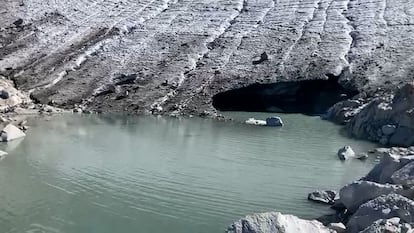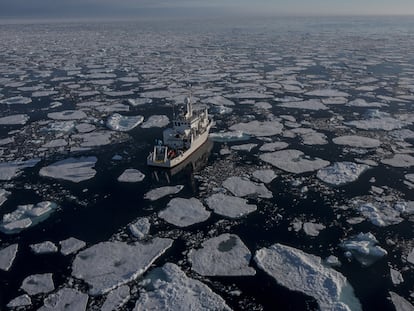Rising temperatures forecast to wipe out Spain’s remaining glaciers in 10 years
The most detailed study carried out on the Aneto glacier in the Pyrenees shows that it is in a ‘terminal’ state

A group of biologists and geographers recently climbed the Aneto glacier, the largest in Spain, to study a kind of black mucus that has appeared on the surface of the ice. These have been identified as cryoconite, a microcosm of rock particles, bacteria, and soot, which is another marker that the glacier is in a terminal state. These black spots trap heat and increase the melting of the ice, which is already accelerated in the region after two years of searing summer temperatures.
The research on the evolution of this ice mass, one of the most emblematic in the Pyrenees and which draws thousands of visitors each year, has just been published. The scientists used different methods to calculate the retreat of the glacier from 1981 to the present. The results read like an obituary. The glacier is following an ever-accelerating trend of disappearance and recent heat waves have tripled its loss of ice. In 2022 alone, the glacier lost three meters of thickness on average, the highest figure ever recorded and coinciding with a year of record temperatures throughout Spain.
Logic appeared to dictate that the disappearance of the Pyrenean glaciers should be slowing. There is less and less ice left to melt and it is accumulating in the highest and shadiest areas of the mountain range. But the new research shows that the melting on Aneto is speeding up. Since 1981, the ice has lost 30 meters of thickness, equivalent to a ten-story building. The total extent of the glacier has been reduced by 64%. In 1850, when global temperatures began to rise steadily during the Industrial Revolution, there were 52 glaciers in the Pyrenees. By 2020, only 21 remained and almost 90% of their entire surface area has been lost.
“In around 10 years Aneto will no longer be a glacier”
Nacho López-Moreno, a researcher at the Pyrenean Institute of Ecology (IPE) and a veteran researcher of the range’s glaciers, sums up the findings, published by the European Geosciences Union, which conclude that the state of the Aneto glacier is terminal. “In recent years, the glacier has been losing a meter and a half of thickness per year. Taking into account that on average there is a median thickness of about 11 meters, in around 10 years Aneto will no longer be a glacier. But if we also see more summers like the one in 2022, it won’t hold out that long,” says López-Moreno.
López-Moreno’s team has spent years studying the last perpetual ice in Spain with an unprecedented level of detail and with unique personal dedication. As soon as they climb down a wall to recover a weather station crushed by snow, they ascend steep slopes or set up makeshift camps to spend the night in the mountains in the depths of winter. For the latter study, the team deployed ground-penetrating radar (GPR). To this data was added high-resolution photos taken by drones and the use of aerial photographs provided by the National Geographic Institute. “The GPR launches a signal that goes through the ice, bounces back and, depending on how long it takes to return, we know its exact thickness at each point,” explains Eñaut Izaguirre, a geographer at the University of the Basque Country. These statistics were “vital” to be able to compare the new data with the relief models from 1981 to 2022, he adds.
Aneto has entered terminal decline. There is hardly any surface area left for fresh snow to accumulate in winter. The glacier has been split in two and the largest part will soon fragment into three other sections, which will accelerate its eventual disappearance. Ice will stop flowing down the slope of the mountain — an essential feature of a glacier — until there is only a motionless frost just below Maldito, Aneto’s neighboring peak. “With the thaw, these mountains are becoming more dangerous,” explains Izaguirre. The ice in the crevices of the rocks is melting and more and more blocks are falling. These landslides are more pronounced in summer, when the glacier attracts the highest number of visitors. The debris ends up covering the ice and acts as a radiator that also serves to accelerate melting.
One of the most spectacular testaments to the speed with which Spain’s last remaining glaciers are disappearing is a turquoise lake that formed in 2015: known as the Innominato, it is located at 3,150 meters above sea level and is the highest in the Pyrenees. It is a precursor to how the landscape and the organisms that inhabit it will change as the ice disappears, forming ibones, or Pyrenean lakes. IPE researcher Ixeia Vidaller explains that the team has calculated what the Aneto landscape will be like when there is no ice left. “In the deepest areas, two or three other lakes will probably form in addition to the Innominato. Although so many rocks may fall from the walls that they could fill these reservoirs,” he says.
The high temperatures recorded in 2022 have also wreaked havoc on the other great Pyrenean glacier, Monte Perdido, where larger and larger blocks are breaking off. In 2022, this glacier lost almost four meters of average thickness, a record, says Jesús Revuelto of the IPE. “During the most favorable years the glaciers of the Pyrenees hold up, but during the bad years, the losses completely tip the balance. The glaciers are becoming confined to the coldest and shadiest areas, but despite this they continue to melt at an accelerated rate.”
This year is likely to be almost as bad as 2022 Although temperatures have not been as high, there are still two months of melting ahead until the first snows of autumn. If Spain experiences a few more summers along current temperature lines, the glaciers are likely to disappear before the end of the decade.
Sign up for our weekly newsletter to get more English-language news coverage from EL PAÍS USA Edition
Tu suscripción se está usando en otro dispositivo
¿Quieres añadir otro usuario a tu suscripción?
Si continúas leyendo en este dispositivo, no se podrá leer en el otro.
FlechaTu suscripción se está usando en otro dispositivo y solo puedes acceder a EL PAÍS desde un dispositivo a la vez.
Si quieres compartir tu cuenta, cambia tu suscripción a la modalidad Premium, así podrás añadir otro usuario. Cada uno accederá con su propia cuenta de email, lo que os permitirá personalizar vuestra experiencia en EL PAÍS.
¿Tienes una suscripción de empresa? Accede aquí para contratar más cuentas.
En el caso de no saber quién está usando tu cuenta, te recomendamos cambiar tu contraseña aquí.
Si decides continuar compartiendo tu cuenta, este mensaje se mostrará en tu dispositivo y en el de la otra persona que está usando tu cuenta de forma indefinida, afectando a tu experiencia de lectura. Puedes consultar aquí los términos y condiciones de la suscripción digital.
More information
Archived In
Últimas noticias
Most viewed
- Reinhard Genzel, Nobel laureate in physics: ‘One-minute videos will never give you the truth’
- Oona Chaplin: ‘I told James Cameron that I was living in a treehouse and starting a permaculture project with a friend’
- Pablo Escobar’s hippos: A serious environmental problem, 40 years on
- Charles Dubouloz, mountaineering star, retires at 36 with a farewell tour inspired by Walter Bonatti
- Why we lost the habit of sleeping in two segments and how that changed our sense of time












































